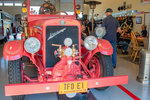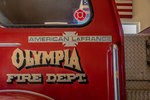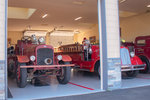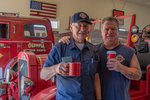




In a garage near Littlerock sits the second firetruck to ever be used by Olympia firefighters, among other decommissioned trucks, gear and most importantly, a couple dozen firefighters who have worked to create this makeshift museum.
Retired firefighters continued to trickle in throughout the late morning. On their badges, Tumwater, West Thurston, Olympia, Seattle and beyond are represented. Despite being from all different places, the conversation was flowing as easily as the coffee.
The “living museum,” as it is referred to by West Thurston Fire Authority Chief Robert Scott, was organized by Larry Dibble, former Olympia fire chief, who said his mission statement for the place is to “keep tradition alive.”
It is hosted by property owner Ray McDonald, also an alumnus of Olympia Fire.
The folks who visit each Monday morning are mostly in their retirement years. With some of the firetrucks not too much older than they are, if they don’t work to document the history of fire service in the area, nobody will.
Dibble and McDonald recently purchased the City of Olympia’s engine No. 3, which began its service in 1937. On the walls of the garage hang portraits of firefighters who have passed away, among other pieces of history from Littlerock, Tumwater and Olympia.
“It evolved into people coming out on Mondays, so we call it Motor Monday,” Dibble said. “We take care of fire engines or just sit here and BS. We’re really good at that. The oral history of the Olympia Fire and Tumwater Fire departments is just pretty tremendous. We are in the process of trying to capture some of the history.”
Maggie Bean, the first female firefighter ever to be hired with Lacey Fire District 3, is among the crew each week.
Since the creation of the homemade museum, she has been recording interviews with the retirees. She asks them to tell stories and give advice to younger generations of firefighters.
“In the fire service, quite traditionally, especially in this area, you work a 24 hour shift. When you work 24 hours with somebody, you become pretty close,” said one attendee, Frank Spickelmire. “Going into a dangerous situation you have to put a lot of trust in that individual. You have a second family, and that’s the fire service. (With) lots of tradition, lots of close ties, it’s pretty hard to walk away from. It’s just embedded in you.”
Scott added that because of the immersive nature of firefighting as a career, folks who don’t have a way to stay connected to their communities after retirement tend to be more prone to health issues and other complications.
“Around the room there is easily a thousand years of fire service experience,” Scott said.
To learn more, email Dibble at larry@olyfirehouse5.com.